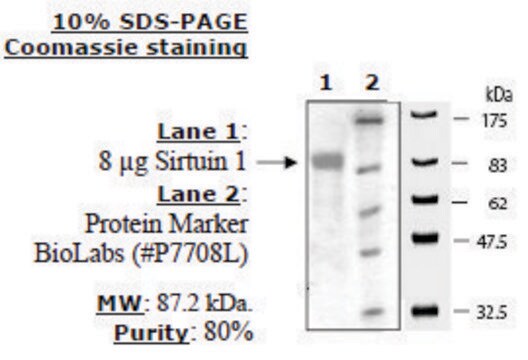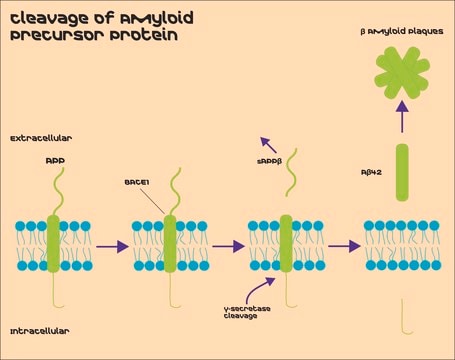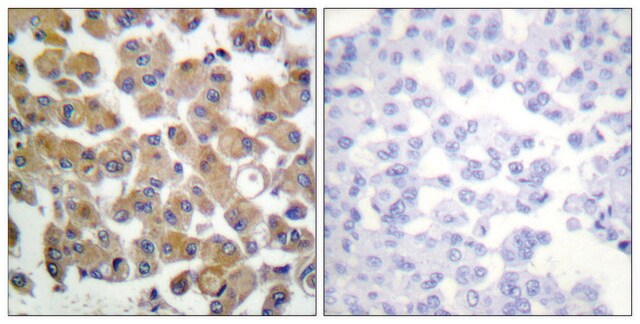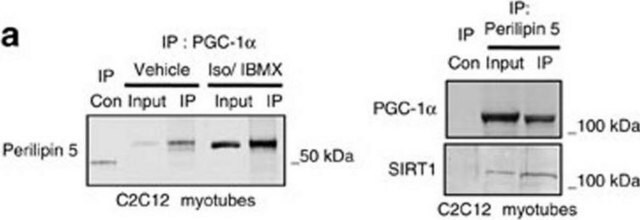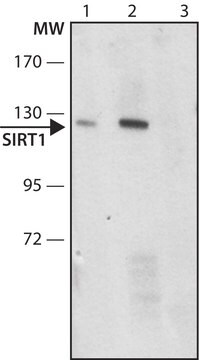CS1040
SIRT1 Assay Kit
sufficient for 100 assays
Sinônimo(s):
SIRT1 Activity Assay
Faça loginpara ver os preços organizacionais e de contrato
About This Item
Código UNSPSC:
12161503
NACRES:
NA.84
Produtos recomendados
uso
sufficient for 100 assays
Nível de qualidade
Condições de expedição
dry ice
temperatura de armazenamento
−20°C
Informações sobre genes
human ... SIRT1(23411)
Descrição geral
The SIRT1 Assay Kit offers all the reagents required for the measurement of purified SIRT1 activity and for screening of inhibitors/activators.
The assay procedure is based on a two-step enzymatic reaction. The first step is deacetylation by SIRT1 of a substrate that contains an acetylated lysine side chain. The second step is the cleavage of the deacetylated substrate by the Developing Solution and the release of a highly fluorescent group. The measured fluorescence is directly proportional to the deacetylation activity of the enzyme in the sample.
The assay procedure is based on a two-step enzymatic reaction. The first step is deacetylation by SIRT1 of a substrate that contains an acetylated lysine side chain. The second step is the cleavage of the deacetylated substrate by the Developing Solution and the release of a highly fluorescent group. The measured fluorescence is directly proportional to the deacetylation activity of the enzyme in the sample.
Aplicação
SIRT1 Assay Kit has been used in measuring the Sirt1 deacetylase activity in mesenchymal stem cells (MSCs), human retinal endothelial cells (HRECs) and human neuroblastoma SH-SY5Y cells.
Ações bioquímicas/fisiológicas
Sirtuins (Sir2) are an evolutionarily conserved family of NAD+ dependent histone/protein deacetylases that tightly couple the cleavage of NAD+ and the deacetylation of protein substrates. The reaction products are nicotinamide, the deacetylated product, and a novel metabolite, 2′-O-acetyl-ADP-ribose. The proteins within this family are named after the first protein discovered from this family, Sir2 (Silent Information Regulator 2). Besides gene silencing, sirtuin proteins are important in other processes such as cell cycling regulation and fatty acid metabolism. SIRT1 is the human homolog of Sir2 and the one most studied to date. SIRT1 mediates p53 dependent process, transcription regulation, muscle differentiation, adipogenesis, and protection from axonal degeneration. SIRT1 also participates in early embryogenesis, neurogenesis, and cardiogenesis.
Características e benefícios
The kit offers all the reagents required for the fast and easy measurement of purified SIRT1 activity and for screening of inhibitors/activators. Moreover, the kit contains an inhibitor (nicotinamide) and an activator (resveratrol) as negative and positive controls, respectively.
Componentes do kit também disponíveis separadamente
Nº do produto
Descrição
SDS
- SIRT1 Substrate (Fluorometric) 100 μL
- Developer Solution 1.5 mL
- S8446SIRT1 human, recombinant, expressed in E. coli, N-terminal histidine tagged, ≥90% (SDS-PAGE), buffered aqueous glycerol solution 150 μgSDS
- NAD+ Solution 1 mL
produto relacionado
Nº do produto
Descrição
Preços
Código de classe de armazenamento
10 - Combustible liquids
Ponto de fulgor (°F)
188.6 °F
Ponto de fulgor (°C)
87 °C
Certificados de análise (COA)
Busque Certificados de análise (COA) digitando o Número do Lote do produto. Os números de lote e remessa podem ser encontrados no rótulo de um produto após a palavra “Lot” ou “Batch”.
Já possui este produto?
Encontre a documentação dos produtos que você adquiriu recentemente na biblioteca de documentos.
Os clientes também visualizaram
Haiyan Chu et al.
American journal of respiratory cell and molecular biology, 58(1), 28-39 (2017-08-12)
Pulmonary fibrosis is the leading cause of death in systemic sclerosis (SSc). Sirtuin1 (SIRT1) is a deacetylase with known antiinflammatory and antifibrotic activity in the liver, kidney, and skin. The role of SIRT1 in SSc-related pulmonary fibrosis is unknown. In
Flávia Gerelli Ghiraldini et al.
Molecular biology of the cell, 24(15), 2467-2476 (2013-06-14)
Hyperglycemia, like aging, induces chromatin remodeling in mouse hepatocytes in comparison to normoglycemia and younger age, respectively. Changes in glucose metabolism also affect the action and expression of sirtuins, promoting changes in chromatin conformation and dynamics. Here we investigate the
Kai Le et al.
International immunopharmacology, 75, 105779-105779 (2019-07-31)
Neonatal hypoxic-ischemic brain injury (HIBI) is a knotty disease that lacks appropriate treatment. Inflammation is an important contributor to brain damage, and microglia are responsible for eliciting early and pronounced inflammatory reactions in the immature brain after hypoxic-ischemic (HI) insult.
Yue Liu et al.
The Journal of experimental medicine, 213(11), 2473-2488 (2016-11-05)
Abdominal aortic aneurysm (AAA), characterized by a localized dilation of the abdominal aorta, is a life-threatening vascular pathology. Because of the current lack of effective treatment for AAA rupture, prevention is of prime importance for AAA management. Calorie restriction (CR)
Jun Zhang et al.
Biochimica et biophysica acta, 1861(7), 1715-1728 (2017-03-17)
Myocardial fibrosis contributes to cardiac dysfunction. Astaxanthin (AST), a member of the carotenoid family, is a well-known antioxidant, but its effect on and underlying mechanisms in myocardial fibrosis are poorly understood. In vivo, myocardial fibrosis and cardiac dysfunction were induced
Nossa equipe de cientistas tem experiência em todas as áreas de pesquisa, incluindo Life Sciences, ciência de materiais, síntese química, cromatografia, química analítica e muitas outras.
Entre em contato com a assistência técnica
